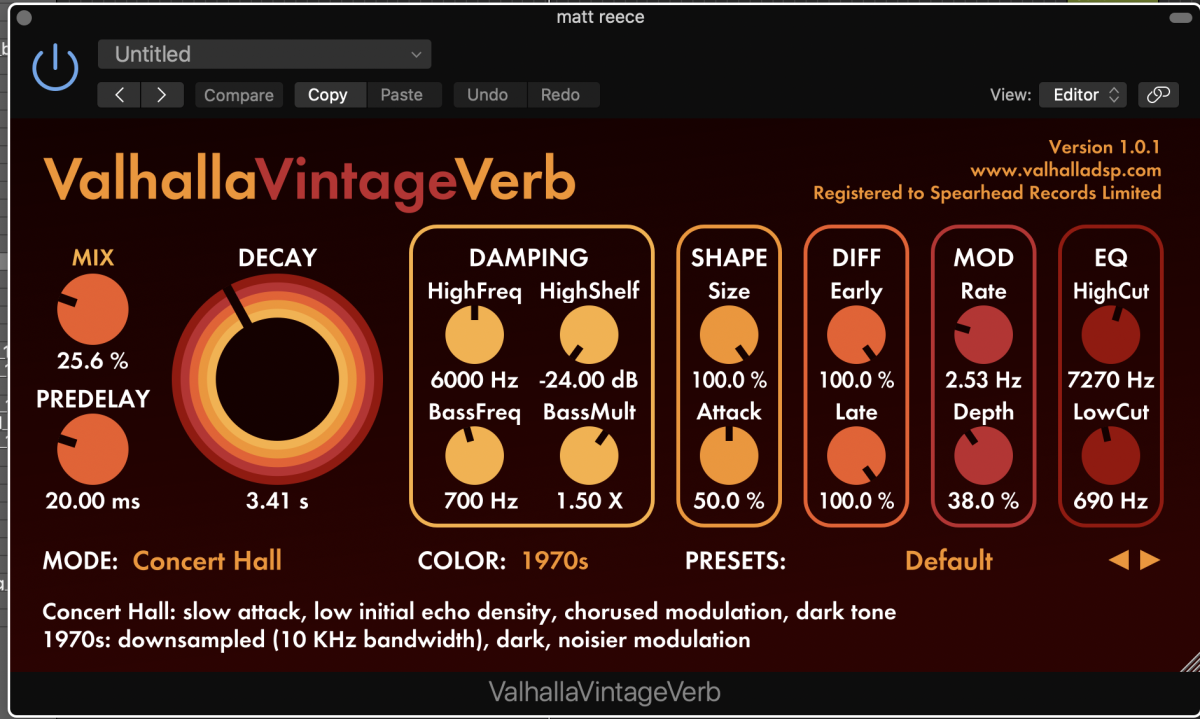

Inspired by early 1980s plate algorithms. Similar to the Concert Hall algorithm, but with a brighter initial sound, and deeper and lusher modulation. Huge spatial image, echo density that can be adjusted from very sparse to very dense, and lush chorusing modulation.īright Hall. Based on the hall algorithms of the late 1970s and early 1980s. ValhallaVintageVerb is a postmodern reverb plugin, inspired by the classic hardware digital reverbs of the 1970s and 1980s.Ĭoncert Hall. He updates often adding to & enhancing his great products always for free. If you haven't dealt with Sean,he is one of the most accessible & nicest developers I've ever dealt with. Valhalla VintageVerb,I'm sure it's amazing as Valhalla Room already is and it's only $50. Interesting field, psycho-acoustics! (I have a major in psycho-physics - never did anything with it until I started Samplicity).OK the reverb market is getting interesting,besides the Lexicon price drop and Exponential Audio's debut relatively soon,there's some very exciting news! People like Griesinger (Lexicon) have done a LOT of research to synthetically create "quasi" realistic reverbs by tricking the ears and brain, for instance by playing with the level between early and late reflections, which we tend to perceive as "realistic", although it is not from a physical point of view. But, to create them, you need a very good emitter AND microphones, that also will or may add coloring. This is something where (good) IRs of real spaces can be a lot better than algo reverbs.


Aka: a digital filter, describing how the original sound has been EQ-ed by materials, comb-filtering due to very close reflections, etc.Īlgo reverbs may take shortcuts here and create unrealistic early reflections.
#Valhalla vintage reverb manual license
I still use Voxengo Pristine Space, a convolution reverb, but it tends to load my poor system down, so I render those tracks, defeating, I suppose, the whole idea of convolution reverb.Īnd if I can ever get the license straightened out I would use Wizzoverb - but alas this is one of those products that suffered from copy protection being over-the-top.ĭelay lines, all-pass filters, this is where convolution gets interesting, especially with real spaces: every early reflection is not just a spike (= echo), but a short peak-and-valley pattern. I also use a Lexicon PCM-90 hardware reverb a lot. My personal favorites, for the moment, include three from UA: EMT 140 Plate, Lexicon 224, OWS, and the Valhalla Vintage. Prices are all over the map, and there is a correlation between price and quality, but it is often violated! and depending on the designer, these too can sound different.

meaning they sound different!Īnd in digital terms the algorithmic reverbs can be based on delay lines or all pass filters (basically two sides of the same coin). All of these have different characteristics. There are mechanical reverbs - springs and plates, there are chambers, their are rooms (both of which are more-or-less self explanatory), and their are purely synthetic reverbs. Ideally I'd like to keep it under $500, though less is, of course, better, provided it still sounds great.Īs Peter points out, there is a difference between algorithmic and convolution reverb - two approaches, and to my ears, they sound different.īut it is much more to it than even that. The only other higher quality reverb I'm aware of is QL Spaces, but I haven't heard much one way or another on that.īudget: I'm willing to pay for quality, to a degree. MIR seems really interesting to me, since (from what I read) it's intended to be used on multiple instruments at once with different settings, and takes into account each instrument's tone. Both sound pretty good, but there's something I don't like about the way either of them handles higher frequencies, so I tend to just roll those off, but I'd prefer not to have to. I currently have Valhalla Room and Audio Damage EOS. #1 use will be to create 'realistic' spaces for sampled real instruments (orchestral mostly), though I wouldn't mind if whatever you suggest was also capable of the occasional crazy effects. Now that I'm working with almost entirely virtual instruments, I'd prefer to keep as much in the virtual realm as possible (for portability / space / ease reasons), and I'm finding myself at a loss as to what to even look for in a plugin reverb (features, specs, etc).Īny suggestions for a really good, really high quality reverb? Algorithmic or convolution, whichever you happen to like better. For the longest time, since I was only recording live rock-oriented bands (drums / guitar / bass), I never got into plugins, and all the reverbs I used were hardware.


 0 kommentar(er)
0 kommentar(er)
